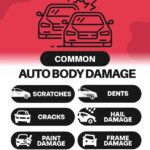Is your beloved car spending more time on the mechanic’s lift than on the open road? Are you pouring money into repairs only to face another breakdown shortly after? It’s a frustrating situation many car owners encounter, leaving you wondering: when is it time to stop repairing and start replacing?
Deciding whether to fix your current car or invest in a new one is a significant financial decision. While the core principle often boils down to comparing your car’s value against the repair costs, several other factors come into play. Your personal budget, the frequency of repairs, safety concerns, and even the fluctuations of the current car market all contribute to this complex equation.
This guide will delve into the critical factors to consider when facing this dilemma, helping you determine when you should not repair your car and instead explore other options.
Key Considerations for Car Repair Decisions
- Car Value vs. Repair Costs: The fundamental question – does the repair cost exceed the car’s worth?
- Repair Frequency: Are breakdowns becoming a regular occurrence?
- Safety Concerns: Are the issues impacting your car’s safety and reliability?
- Current Car Market: How does the cost of repair compare to the cost of replacement in today’s market?
- Budgetary Constraints: Can you afford the repair, or would that money be better spent elsewhere?
Navigating these points will empower you to make an informed decision about your vehicle’s future.
Assessing Your Car’s Value
The first step in this evaluation is to determine the current market value of your car. Reputable online resources like Kelley Blue Book (KBB) and Edmunds are excellent starting points. These platforms allow you to input your car’s year, make, model, mileage, and condition to generate an estimated value.
For example, consider a 2014 Honda Civic with 100,000 miles. In good condition, its estimated value might be around $7,000. However, if this same car requires a major repair like a transmission replacement, its value in its current condition would be significantly lower.
Understanding your car’s value both before and after potential repairs is crucial. This comparison helps you assess whether the repair investment is financially sound or if you’re better off considering other options.
Important Note: If you owe more on your car loan than the car is currently worth, you are in an “upside-down” car situation. In such cases, selling the car might be more complicated and require careful financial planning.
Evaluating Repair Costs
Once you have a grasp of your car’s value, the next critical step is to obtain accurate repair cost estimates. Contact several reputable mechanics or repair shops to get quotes for the necessary repairs, including both parts and labor.
If the total repair cost approaches or exceeds the car’s value (even after the repair), it’s a strong indication that repairing the car might not be the most financially sensible decision. In such scenarios, allocating those funds towards a replacement vehicle may be a wiser move.
However, consider the nature and longevity of the repair. Is it a temporary fix, or a more permanent solution? A costly repair that guarantees years of reliable driving might be justifiable, whereas a cheaper fix that only extends the car’s life for a few months may not be worthwhile.
Let’s revisit our Honda Civic example. A transmission replacement might cost around $4,000. If this repair can reasonably extend the car’s lifespan for several more years, then investing $4,000 in a car valued at $7,000 post-repair could be a sound decision. You retain a functional vehicle without incurring immediate debt for a new car.
Keep in mind that repair costs can vary significantly depending on the type of car you own. Luxury vehicles or foreign models often have higher parts costs and specialized labor rates, making repairs potentially more expensive than those for domestic or economy cars.
Considering Repair Frequency
Beyond individual repair costs, the frequency of repairs is a significant factor. Routine maintenance is expected for all vehicles, but frequent, costly repairs are a red flag. If you find yourself at the mechanic every few months, facing bills of $500-$700 for a car valued at only $7,000, it’s time to seriously consider whether these ongoing expenses are justified.
Research common issues and typical lifespans for your car’s make and model. Online car forums and owner communities can provide valuable insights into the long-term reliability and potential problem areas of your specific vehicle. Brands like Toyota, Honda, and Lexus are generally known for their longevity and durability, often exceeding 200,000 miles with consistent maintenance. Holding onto such vehicles, even with some repairs, might be more economical in the long run.
However, if your car has become a frequent visitor to the repair shop, becoming a source of constant stress and financial drain, it’s time to evaluate the true cost of ownership, considering not just the money spent but also the lost time and inconvenience.
Safety Implications
Safety should always be a paramount concern. While the desire for a new car can be tempting, it’s crucial to differentiate between genuine safety issues and a mere desire for an upgrade. Malfunctioning transmissions, broken lights, compromised brakes, or steering problems are undeniably safety hazards that demand immediate attention and repair.
However, an older car with higher mileage isn’t inherently unsafe. A thorough inspection by a qualified mechanic can determine if there are any critical safety concerns and whether they can be reliably and cost-effectively addressed.
Ultimately, if safety is a primary concern, consult with a trusted mechanic. They can provide an objective assessment of your car’s condition and advise on necessary repairs to ensure safe operation.
The Current Car Market Dynamics
The state of the current car market plays a significant role in the repair-or-replace equation. While facing a car repair bill is never pleasant, the cost of replacing a vehicle, particularly in a fluctuating market, can be even more daunting. Current car prices and availability can significantly impact your decision.
In times of limited car supply and elevated prices, opting to repair your current car, even with a substantial bill, might be more financially prudent than entering the market to purchase a replacement vehicle at an inflated price.
For instance, a $700 repair bill, while unwelcome, pales in comparison to the average new car payment, which can easily exceed $700-$800 per month when financing a new vehicle. Avoiding a new car loan and its associated long-term costs can be a significant financial advantage.
Avoid rushing into a car purchase you can’t truly afford. Monitor the car market conditions and make a decision that aligns with your current budget and financial situation. Repairing your existing car to extend its life while you save for a replacement might be a sensible strategy, or, if you have the financial means, upgrading now could be a viable option.
Repairing Your Car: Strategies to Consider
If you decide that repairing your car is the most suitable option, here are some strategies to manage costs effectively:
Shop Around for Quotes
Don’t settle for the first repair estimate you receive. Obtain diagnoses from reputable dealerships or larger repair shops, but recognize that their initial quotes might not be the most competitive. Labor costs, often a significant portion of the bill, tend to be higher at larger, more established facilities.
Seek recommendations from friends, family, or online reviews for reliable mechanics offering fair prices. Call multiple shops to compare quotes and inquire about potential discounts or specials.
DIY Repairs Where Possible
Identify repairs you can handle yourself. While complex mechanical work should be left to professionals, simpler tasks like replacing a door handle, changing air filters, or replacing windshield wipers can be tackled at home with online guides and tutorials, saving on labor costs. Be realistic about your skills and limitations, and never compromise safety for DIY savings.
Prioritize Essential Repairs
If repair costs exceed your immediate budget, discuss with your mechanic which repairs are critical for safety and function and which can be deferred. Safety-related repairs like brakes, tires, and critical engine components should be prioritized. Cosmetic repairs or non-essential features like power windows or sound systems can often wait until you have saved sufficient funds.
Replacing Your Car: Smart Approaches
If you conclude that replacing your car is the more practical choice, consider these smart strategies for a cost-effective transition:
Opt for Used Over New
While a brand-new car with a warranty is appealing, the rapid depreciation of new vehicles makes used cars a far more financially sound choice. New cars lose a significant percentage of their value in the first few years, absorbing the steepest depreciation.
Used cars offer substantial savings and can still provide reliable transportation. Focus on finding a well-maintained used car from a reputable source. Thorough research and pre-purchase inspections are key to finding a reliable used vehicle that meets your needs without breaking the bank.
Pay with Cash
Avoid car loans if possible. Financing adds significant long-term costs due to interest charges. Saving and paying cash for a car, even if it means a less expensive model initially, is a much more financially prudent approach. Car loans create debt and can lead to paying significantly more than the car’s actual value over time.
Save for Your Ideal Car
If your current budget doesn’t allow for your desired replacement car, create a savings plan. Purchase a reliable, affordable used car that meets your immediate transportation needs while you diligently save the difference between its cost and your target car’s price. Allocate a fixed amount each month towards your car savings goal, treating it like a car payment to yourself. This strategy allows you to upgrade to your desired vehicle without incurring debt.
Budgeting: The Foundation for Car Ownership Decisions
Regardless of whether you choose to repair or replace your car, effective budgeting is essential for managing car ownership costs. A comprehensive budget helps you anticipate and plan for all vehicle-related expenses, including fuel, insurance, routine maintenance, and potential repairs, as well as setting aside funds for future car replacement.
A budget provides clarity and control over your finances, enabling you to make informed decisions about car repairs and replacements within the context of your overall financial goals. Utilize budgeting tools and apps to track your income, expenses, and savings, empowering you to confidently manage your car ownership journey.
Making the decision to repair or replace your car requires careful consideration of various factors. By thoroughly evaluating your car’s value, repair costs, frequency of issues, safety, and the current market, alongside your budget, you can arrive at the most financially sound and practical decision for your individual circumstances.


